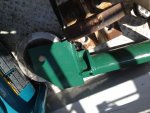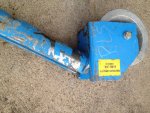Interesting photos. Are you sure that damage is not happening during the pull caused by damaged pipe? It would be painful to pull it all again and have the same thing happen.
The intent of this thread was to learn how to pull large conductors in two directions from a midpoint pull-box, without creating a bird's nest of wires. But since you inquired about the cause of the damage, I'll give you the back story.
The five parallel sets of conduit were 15 years old and four of them contained the (16) 500 MCM aluminum feeders which powered our facility. The installation contractor removed these existing wires from the four conduits and re-pulled them into two of the conduits so that he would have three open conduits through which to pull (18) new 350 MCM copper solar feeders. This is what the in-ground pull-box looked like when it was first unearthed and opened after 15 years:
.
And this is what it looked like after the soil was removed from the box (by hand using a plastic scoop, so as not to damage the wires):
.
The concrete lower section of this box was formed-in-place, with a solid concrete floor. Over the years, dirt and rocks had washed into the box through gaps between the square corners of the formed-concrete part of the box, and the rounded-corners of the extension ring atop it. The soil had completely buried the wire and conduit openings. The conduits to the distribution panel slope down at an angle away from the box, as pictured in this diagram:
A rational person would presume that at least
some debris had washed down into those conduits over the years. In fact, in the 4th photo above you can even see dirt inside the conduit. Nevertheless, the installation contractor did
not proof the conduits (despite promising to acquire a mandrel to do so), did
not brush or swab the conduits to clean them out, did
not visually inspect the conduits (not required, but if I were doing the install, I would have done so to CMA), and did
not lubricate the conduits prior to the pull.
I observed the pulls that were performed 18 months ago and I objected to -- and documented -- the pulling methods employed, but my concerns were not addressed. In fact, I concluded at the time that these conductors were very likely damaged during the installation and predicted their probable failure. However, I did not anticipate the extent of the total damage: out of nine runs of conduit in this job, six contained failed feeders. So the damage was not just limited to the re-used aluminum feeders, but a number of brand-new copper feeders were damaged as well. Specifically, the damage comprises eleven out of sixteen damaged 500 MCM AL-XHHW feeders (two out of two conduits; 3,960 ft of wire), three out of eighteen damaged 350 MCM CU-XHHW feeders (two out of three conduits; 2,100 ft of wire), and two out of twelve 500 MCM CU-XHHW feeders (two out of four conduits; 1,120 ft of wire).
So, back to the present day and your question...
After we removed the shorted aluminum feeders pictured above, we pulled a rubber disc mandrel through the conduits and pulled out 6 or 8 angular rocks that were inside the conduit, each about 1" in size. After swabbing, we ran an inspection camera through that conduit and there was no visible damage to the PVC, not even from the violent arcing that occurred at the time of the short (the water inside the conduit probably helped there). Other conduits with damaged conductors will be swabbed and inspected after the existing wires are removed.
Actually, I'm very surprised that the PVC conduit wasn't ruptured by the shock wave of the "explosion" that occurred when the conductors shorted. The short was located near midspan in the 200' conduit run, and water had been ejected from the conduit into the distribution panel with such force, that the entire utility room that houses the distribution panel was wet -- with water dripping off the ceiling and walls -- even though the distribution panel was completely closed with only some small louvered vents at the bottom and top of the front panel.













